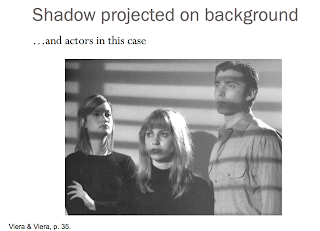RTD 365A
Lighting Exercise
Assigned 9/14/15
Due 9/23/15 and 9/24/15
This assignment gives
practice in seeing light as an intentional manipulation of the space inside the
frame. It will give you practice in describing what you see and the accompanying
reading will introduce you to some terms that are used to describe lighting.
Lighting Analysis assignment:
Select two scenes
from a day or nighttime serial tv/cable drama or sitcom. Or from a movie.
The scenes you
select MUST be interiors because we want to look at how light is artificially
manipulated to create a natural looking space as you will do in some of your
work.
You can use
the same series, but you will need to select two different scenes- in different
locations. You will need to get
still images from this- so it is easier to use online sources of the series.
You don’t need to watch the whole thing though- so even if you find a clip
online, that will work.
While
watching, stop the player and select a still from this scene. Below are instructions for making a
screenshot.
Look carefully
at the lighting in this scene. I
want you to describe what you see.
You do not need to guess at what kind of
lighting instrument they have used.
Describe the
visual components – the way space, shapes, lines, colors, and tone is
constructing the space because of the lighting.
How is depth
constructed or ignored- because of the lighting?
You can use words
to describe lighting characteristics drawn from the Millerson reading.
These are intensity, quality, contrast, direction and
temperature.



